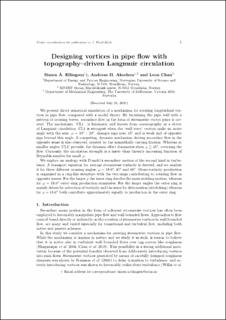| dc.contributor.author | Ellingsen, Simen Andreas Ådnøy | |
| dc.contributor.author | Akselsen, Andreas Holm | |
| dc.contributor.author | Chan, Leon | |
| dc.date.accessioned | 2021-09-14T07:36:31Z | |
| dc.date.available | 2021-09-14T07:36:31Z | |
| dc.date.created | 2021-09-10T12:44:21Z | |
| dc.date.issued | 2021 | |
| dc.identifier.citation | Journal of Fluid Mechanics. 2021, 926 . | en_US |
| dc.identifier.issn | 0022-1120 | |
| dc.identifier.uri | https://hdl.handle.net/11250/2776357 | |
| dc.description.abstract | We present direct numerical simulation of a mechanism for creating longitudinal vortices in pipe flow, compared with a model theory. By furnishing the pipe wall with a pattern of crossing waves, secondary flow in the form of streamwise vortex pairs is created. The mechanism, ‘CL1’, is kinematic and known from oceanography as a driver of Langmuir circulation. CL1 is strongest when the ‘wall wave’ vectors make an acute angle with the axis, φ=10∘–20∘, changes sign near 45∘ and is weak and of opposite sign beyond this angle. A competing, dynamic mechanism driving secondary flow in the opposite sense is also observed, created by the azimuthally varying friction. Whereas at smaller angles ‘CL1’ prevails, the dynamic effect dominates when φ≳45∘, reversing the flow. Curiously, the circulation strength is a faster-than-linearly increasing function of Reynolds number for small φ. We explore an analogy with Prandtl's secondary motion of the second kind in turbulence. A transport equation for average streamwise vorticity is derived, and we analyse it for three different crossing angles, φ=18.6∘,45∘ and 60∘. Mean-vorticity production is organised in a ring-like structure with the two rings contributing to rotating flow in opposite senses. For the larger φ, the inner ring decides the main swirling motion, whereas for φ=18.6∘, outer-ring production dominates. For the larger angles, the outer ring is mainly driven by advection of vorticity and the inner by deformation (stretching) whereas, for φ=18.6∘, both contribute approximately equally to production in the outer ring. | en_US |
| dc.language.iso | eng | en_US |
| dc.publisher | Cambridge University Press | en_US |
| dc.rights | Attribution-NonCommercial-NoDerivatives 4.0 Internasjonal | * |
| dc.rights.uri | http://creativecommons.org/licenses/by-nc-nd/4.0/deed.no | * |
| dc.subject | pipe flow | en_US |
| dc.subject | microfluidics | en_US |
| dc.subject | vortex dynamics | en_US |
| dc.title | Designing vortices in pipe flow with topography-driven Langmuir circulation | en_US |
| dc.type | Peer reviewed | en_US |
| dc.type | Journal article | en_US |
| dc.description.version | acceptedVersion | en_US |
| dc.rights.holder | © The Author(s), 2021. Published by Cambridge University Press. VoR is avalable at: DOI: https://doi.org/10.1017/jfm.2021.696 | en_US |
| dc.source.pagenumber | 24 | en_US |
| dc.source.volume | 926 | en_US |
| dc.source.journal | Journal of Fluid Mechanics | en_US |
| dc.identifier.doi | 10.1017/jfm.2021.696 | |
| dc.identifier.cristin | 1933247 | |
| cristin.ispublished | true | |
| cristin.fulltext | original | |
| cristin.fulltext | postprint | |
| cristin.qualitycode | 2 | |

